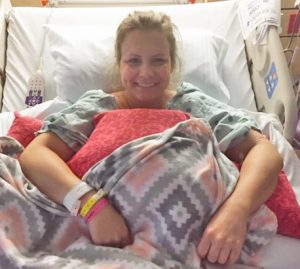In celebration of Christina Kuzma’s successful fight against breast cancer at the age of 33, Tx:Team brings you Part Two of our weekly series to share her experience making decisions about her treatment.
These days, Christina Kuzma is at work like usual, hosting meetings, educating whomever she can about Tx:Team services, and plugging in a radiation treatment where they fit. She’s doing extremely well but it has been a long road to get to this point. From her month of “scanxiety” in February after receiving her diagnosis to feeling like she’d been hit by a truck throughout her 4 months of chemotherapy, Christina faced incredible pains in her mind and in her body. But before she could tackle her cancer, she knew that she had to get her head right. Her motto was simple, which kept her focused: “I won’t back down.” And with that, she prepared herself to fight by placing her trust in the treatment plan and her physical therapy regime.
LIVING LIFE NORMALLY, BUT WITH A LITTLE EXTRA UMPH
If you’re already humming Tom Petty, you’re right there with Christina. Petty’s song, “I Won’t Back Down” strengthened her during the toughest weeks of chemotherapy. He’s a big deal in the Kuzma family. Just this past month, Christina’s daughter, at 3 years old, proudly declared that she was going as Tom Petty for Halloween.
Well, I know what’s right
I got just one life
In a world that keeps on pushin’ me around
But I’ll stand my ground
And I won’t back down
The Grateful Dead’s “Touch of Grey” was a second anthem. Some days, carrying on with normal activities during chemo was really hard. However, the sun was still shining and her heart was still beating, so Christina echoed Garcia: “I will get by, and I will survive this day!”
To keep things normal, Christina launched her favorite saying: “controlling the controllables.” Amongst the loss of control that is cancer, she took hold of what she could.
Most importantly, she continued working during chemo. She arranged Thursday infusions so that she could take Fridays off and rest over the weekends. Even so, Mondays were agonizing, and Tuesdays weren’t easy either- like “the worst hangover of your life.” To combat the soreness and fatigue, Christina picked up yoga. Yoga helped her stretch her aching joints. She also opted for cold cap therapy, a non-invasive scalp cooling technique. Keeping her hair was exactly the mind trick she needed. When she didn’t look sick, she didn’t feel as sick. She could look in the mirror and feel like herself. And that extra boost of energy during treatment made a world of difference.
CHRISTINA’S SURGERY

On August 10, 2018, Christina had a bilateral mastectomy and began reconstruction. Her breast surgeon removed all of her breast tissue and 4 lymph nodes to test for any cancer remaining after chemotherapy. Next, the plastic surgeon inserted expanders, which are temporary implants that stretch the skin and optimize radiation treatment. Christina verifies, “Expanders are about as comfortable as they sound. They feel like two bowls just sitting in your chest.” Finally, a drainage tube was inserted on each side of the breast to collect the fluid that gathers after surgery. Altogether, the surgery lasted 6 hours and left her body exhausted and in pain.
In typical Kuzma fashion, Christina focused on the best part of her surgery. She and her family had a small win to celebrate big time- the biopsied tissue came back with zero traces of cancer. Christina’s body had a complete response to the chemotherapy. She paused to reflect on the past months, and at 33 years old, watching as her life flashed before her eyes, she felt aged and wiser. The small stuff is everything, and you’ve got to appreciate the simple things that saturate life in emotion and meaning.
SHE CHOSE PT
Christina’s recovery began full-force on Day 1 in the hospital. The overwhelming pain that follows a surgery like the one Christina had can lead a patient to consider stronger medications for relief. Christina had concluded that stronger pain relievers would not serve her as well as physical therapy could in the long run. The day after surgery, Christina cut off her opioid pain medication, had her first meeting with a physical therapist, and began managing her pain with Tylenol. The therapist introduced exercises for her to practice 3 times a day and she progressed daily.
After all her body had been through in surgery, Christina started basic exercises to soothe her lymphatic system: stretching the neck, deep breathing, and massage. She also made a point to move her arms immediately. Even simple things like eating, brushing her teeth, and combing her hair were taxing. While on a bed, she held her arm above her heart for 45+ minutes. A specially created pillow helped to keep her arm in place, which significantly decreased swelling. And of course, the trusted Tx:Team stress ball came in handy. Katie Guerdan, Manager of HR at Tx:Team, dropped it off in a get-well basket with the challenge to use it. Christina built up to 25 squeezes. By Day 3 post-operation, she was able to begin chest exercises.
In 2 weeks’ time, Christina regained about half of her full range of motion and she could finally wash her hair by herself! A small, but huge win for Christina, for which she was so grateful. That weekend, with drains still in place, she was eager to get busy living. She went out with her family on their boat, content to watch the world around her, and appreciate getting back to living the normal life of Christina Kuzma.

 Kim Brown is a Tx:Team Physical Therapist at FMH Rehabilitation Crestwood, in Frederick, Maryland. While she did not treat Christina directly, Kim is all too familiar with the diagnosis and treatment for patients just like Christina.
Kim Brown is a Tx:Team Physical Therapist at FMH Rehabilitation Crestwood, in Frederick, Maryland. While she did not treat Christina directly, Kim is all too familiar with the diagnosis and treatment for patients just like Christina.
